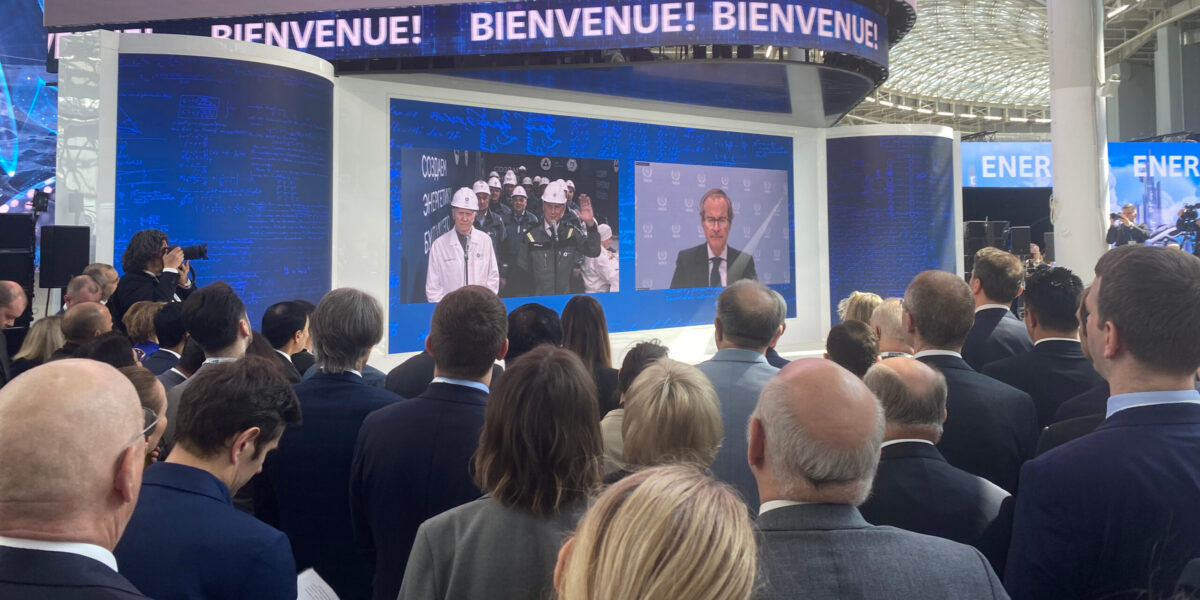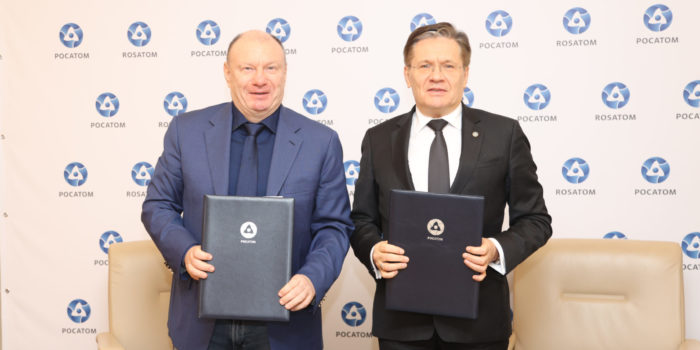During the international forum ATOMEXPO-2024 in Sochi, Rosatom has held a video conference with Seversk in West Siberia (Tomsk region), thus making a ceremony of starting the tests of the unique carbothermal fusion equipment at the facility for manufacturing of nuclear fuel for BREST-OD-300 Gen IV fast reactor. The industrial site is under construction as part of the strategic “Proryv” (or “the Breakhrough”) project.
The ceremony took place with participation of Alexey Likhachev, Director General of Rosatom, Rafael Grossi, Director General of the IAEA (in video conference mode), and Sama Bilbao y León, Director General of the World Nuclear Association. From the shop-floor in Seversk, the launch was accomplished by Evgeny Adamov, scientific director of “the Breakthrough” project, and Sergey Kotov, general director of the Siberian Chemical Combine (an enterprise of Rosatom’s TVEL Fuel Company) where the unique Pilot Demonstration Energy Complex (PDEC) is under construction.
PDEC is a cluster of three interconnected unique facilities, including the nuclear fuel production plant (for fabrication and refabrication), the BREST-OD-300 power unit, and the facility for irradiated fuel reprocessing. For the first time in history, a nuclear power plant powered by a fast reactor will be built alongside closed nuclear fuel cycle servicing enterprises on one site.
The fuel fabrication/refabrication unit is the first of the PDEC facilities to be commissioned, all the works scheduled to be completed by the end of 2024. The first of its process stages is the carbothermal synthesis line, which will be used in the fuel pellet production process: from the batching, mixing and granulation of powder to the sintering of pellets in the carbothermal synthesis furnace.
“Rosatom strategy is aimed at the shift to dual-component nuclear power with wide implementation of fast neutron reactors and closed nuclear fuel cycle technologies. However, achieving strategic goals means enormous work ‘on the ground’ in roder to solve hundreds of research, technological and industrial tasks. In addition to advanced technologies for Generation IV reactors, ’the Breakthrough’ project is boosting a great range of cutting-edge technologies in nuclear fuel fabrication and reprocessing, and that means development of the most advanced chemical machinery engineering. The launch of the fuel manufacturing plant will be the first remarkable milestone of ‘the Breakthrough’ project, which we are moving towards. Everything at this facility is unique – the technology itself, each piece of equipment, its layout; and each production site is a solution to a technological problem that no one else in the world has ever taken on,” commented Alexey Likhachev, General Director of Rosatom State Corporation.
“At the international level, the role of nuclear generation is already fully recognized as a powerful and source of green energy, indispensable to meet the growing global energy demand. Despite the safety of the existing nuclear power technologies, it is necessary to continue system-based improvement of nuclear technologies safety throughout the entire life cycle, i. e. to apply final rather than interim solutions for spent fuel management, to utilize fully the energy potential of natural uranium, and to strengthen the non-proliferation regime. This can be achieved only with the fourth-generation energy systems based on fast neutron reactors. For its part, fast reactors demand some new advanced dense nuclear fuel. We have not just chosen nitride of uranium and plutonium mixture as such fuel matrix, but have also validated its performance to the level that we are used to at nuclear power plants, which use the common uranium dioxide,” said Evgeny Adamov, scientific director of “the Breakthrough” project.
The fourth-generation fast neutron reactor BREST-OD-300 will be the world’s first lead-cooled reactor installation; its architecture is based on the principles of so-called natural safety. The reactor’s efficiency will be also ensured through the use of innovative mixed dense uranium-plutonium nitride nuclear fuel (MUPN-fuel). It consists entirely of secondary products of the nuclear fuel cycle — depleted uranium and plutonium. Thus, its manufacturing and introduction will enable to expand the resource base of the nuclear power industry multifold, reprocess irradiated fuel assemblies instead of storing, and also to reduce the volumes of radioactive waste and its activity.
Distinct from classical nuclear fuel based on enriched uranium dioxide, MUPN fuel cannot be produced with standard technology and equipment. Besides the non-standard fuel matrix, another issues is the use of radioactive plutonium extracted from spent nuclear fuel. To avoid exposure on the staff, manufacturing of uranium-plutonium fuel must be fully automated as possible, almost unmanned. In total, there will be four production lines for fuel fabrication: a line for the carbothermal synthesis of mixed uranium and plutonium nitrides, a line for the production of fuel pellets (thus, manufacturing of pellets will be implemented in two stages), a line for the assembly of fuel rods, and a line for the production of complete fuel cassettes. Currently, commissioning of the installed equipment is underway at the production lines.
Reference
Within the closed nuclear fuel cycle implemented at PDEC, spent fuel from the BREST-OD-300 reactor will be sent for refabrication (i. e. re-manufacturing of fresh fuel) after reprocessing, thus, this system will gradually become almost autonomous and independent of external energy supplies.
The advantage of fast neutron reactors is their possibility to efficiently use secondary products of the fuel cycle (in particular, plutonium) for energy generation. At the same time, having a high reproduction rate, fast reactors are able to produce more potential fuel than they consume, as well as after-burn highly active transuranic elements (actinides).
The BREST-OD-300 reactor will supply itself with the main energy component – plutonium-239, reproducing it from uranium-238 isotope, which is contained in natural uranium ore in excess of 99% (currently, uranium-235 is used for energy production in thermal reactors, the content of which in natural uranium ore is about 0.7%).
As part of the demonstration of Rosatom’s commitment to the climate agenda, the carbon footprint of the 13th International Forum ATOMEXPO-2024 will be compensated using special certificates.





